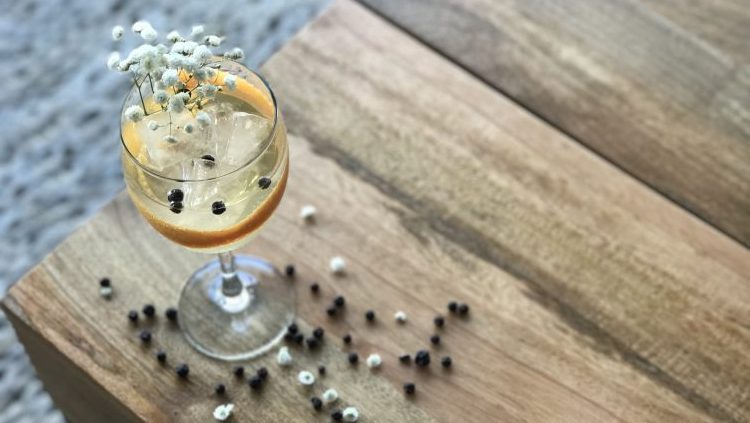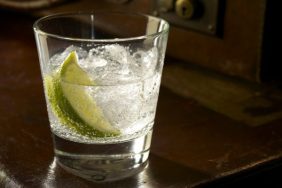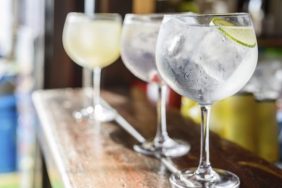Photo: Ellis Adams Group
Today is International Gin & Tonic Day. It’s the one day per year when the whole world celebrates the simple beauty of this iconic cocktail. Gin, tonic, lime, and nothing else. That’s the way it’s supposed to be, right? It’s hard to believe anyone would want to change something so perfect, but if they did, how could they possibly make it better? Well, let us introduce you to the Spanish Gin Tonic (in Spain, the ampersand is omitted). If you’ve never experienced this popular variation of the classic cocktail, you’re really missing out.
What is the Spanish Gin Tonic?
When most of us think about the classic gin and tonic, we envision the English version: a rocks or highball glass filled with ice and a couple of ounces of gin, topped with tonic water and a squeeze of lime. But in Spain (and other places where they have adapted this style), a few extra ingredients are involved. “The Spanish Gin Tonic is a more elaborate version of the simple drink that places equal importance on every ingredient from the gin to the tonic to the ice to the freshness of the garnishes,” says beverage educator Anthony Pullen.
The differences between the classic and Spanish versions of the gin and tonic are noticeable immediately. The classic G&T is a highball drink made with simple ingredients. “The most visually striking differences between a traditional G&T and a Spanish Gin Tonic are the large wine glass or goblet in which it’s served and the colorful garnishes like herbs, flowers, and fruit with which it’s finished,” says Pullen.
Beyond Whisky: Suntory Expands to Vodka And Gin
While we might just grab any tonic we find at our neighborhood grocery store, the Spanish place as much importance on the quality of the tonic as on the gin. “When you’re talking about a two-ingredient drink in which one of those ingredients, in this case, the tonic, makes up 70 percent of the recipe, it makes sense to pay attention to it,” Pullen says.
Pullen typically uses mixes from brands that use real quinine. “Yes, there are tonics with quinine flavoring, and they’re gross,” says Pullen. One brand he trusts is Q. He likes it because it has a drier profile than other tonics on the market. He believes that carbonation is equally important, so the drink has the same bubbles on your last sip as it does on your first. “Use original tonic if you’re mixing with a modern-style gin like Hendrick’s, Brooklyn, or Bluecoat,” he says. “If you’re using a London Dry, use Indian Tonic. It has a lot of backbone so it can stand up to even the most juniper-forward gins.”
A Mysterious History
Like so many things in the cocktail world, it’s difficult to be 100 percent sure of the history of the Spanish Gin Tonic. “One of the more widely accepted histories starts with a Spanish journalist by the name of Rafael García Santos in San Sebastián, which is one of the world’s gastronomy capitals,” says Pullen. (Check out the season nine, episode two of Parts Unknown for a little more context.) “For about a decade, Santos gathered chefs together regularly to kibbutz and exchange ideas at bars that served great gin and tonics.” Eventually, it got out that the Gin Tonic was the off-hours beverage of choice for big-name chefs. Bars in San Sebastian were turning them into works of visual art and a trend was born.
Steakhouse Whiskey: LongHorn Releases Its Own Bourbon
Spain’s enthusiasm for all things gastronomic is certainly one of the reasons for the drink’s popularity. “There’s also the relationship between Catalonia, where Barcelona is, and England,” says Pullen. That traditional G&T we mentioned earlier is unequivocally an English staple. “Taking into account all the points in history at which Catalonia and England teamed up to further a common cause – think of Englishman George Orwell’s book Homage to Catalonia, in which he chronicles fighting with the Catalans against the Spanish crown – and it shouldn’t come as much of a surprise that certain English things stuck.”
Also, next time you’re watching famed footballer Leonel Messi play for Barcelona, take a closer look at the team crest in the upper left-hand corner of his jersey. “You’ll notice it includes the cross of Saint George – the same cross on England’s flag.” The countries seem to be forever linked, so why shouldn’t that extend to a cocktail?
Popular Spanish Gin Tonic Ingredients
When determining Spanish Gin Tonic ingredients, there is an obvious link to food culture. “I think the most important concept to get across is that like everything else relating to gastronomy that has roots in Spain’s Basque region, the quality of the ingredients is of utmost importance. Great gin, great tonic, quality ice, and fresh garnishes,” says Pullen. Popular ingredients include cucumbers, juniper berries, lemon wheels, thyme, vanilla beans, saffron, mint, sage, and chile peppers.
Pullen hopes everybody reading this is inspired to throw a Spanish Gin Tonic party. “Invite a few friends over, lay out some wine glasses, fresh ice, a great bottle of gin, a few bottles of quality tonic, and saucers with fresh garnishes, and share the Spanish Gin Tonic experience.”









